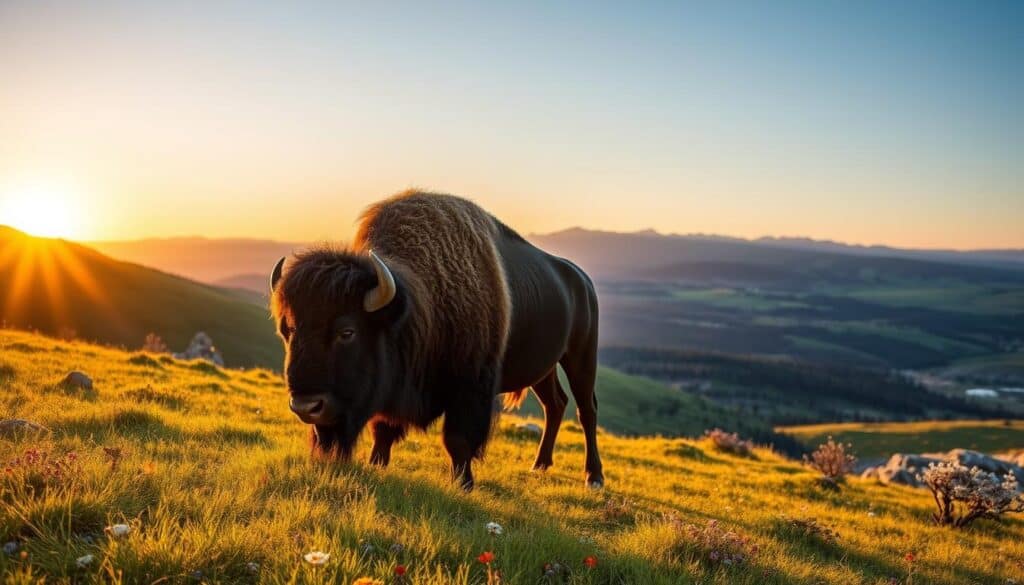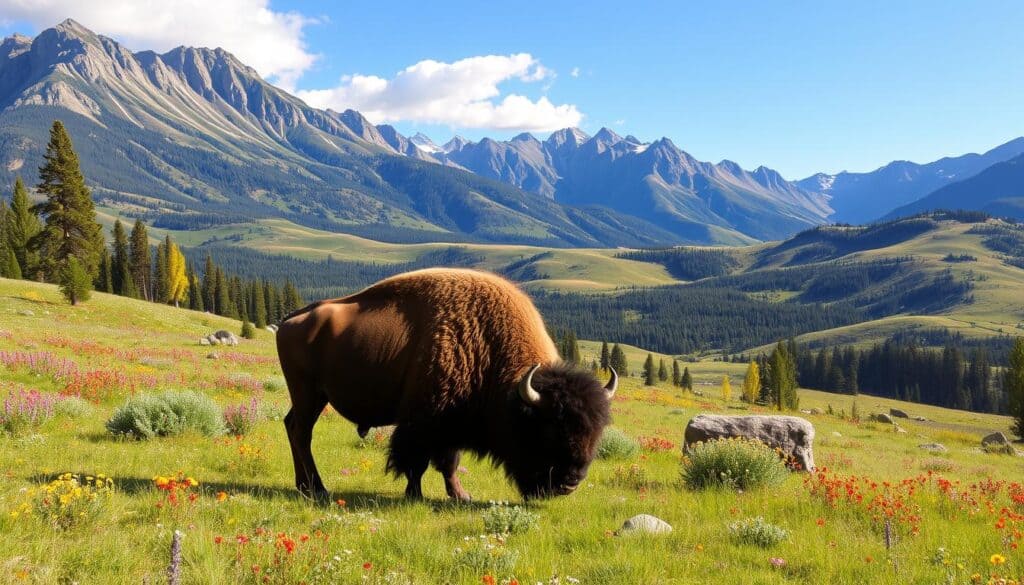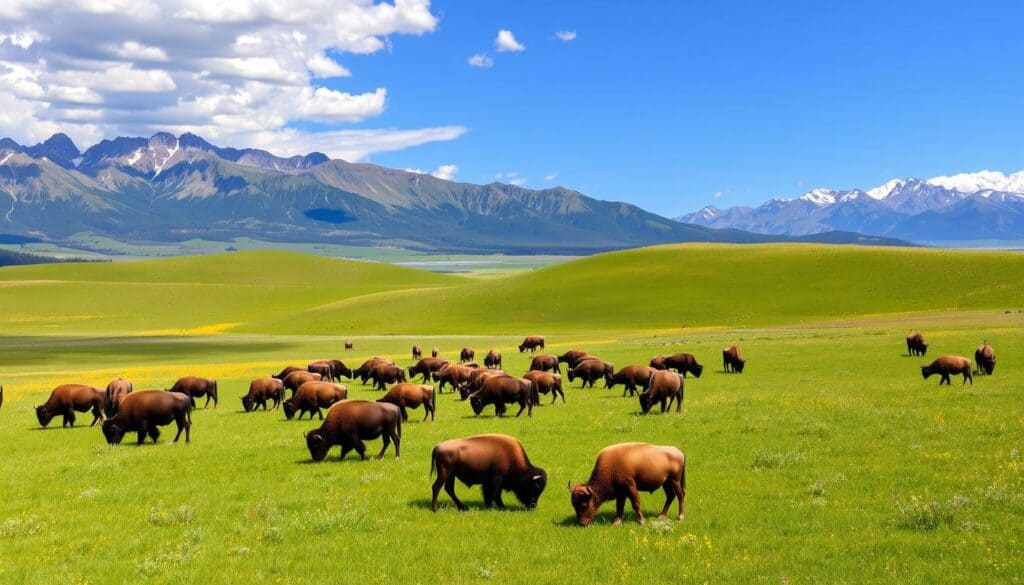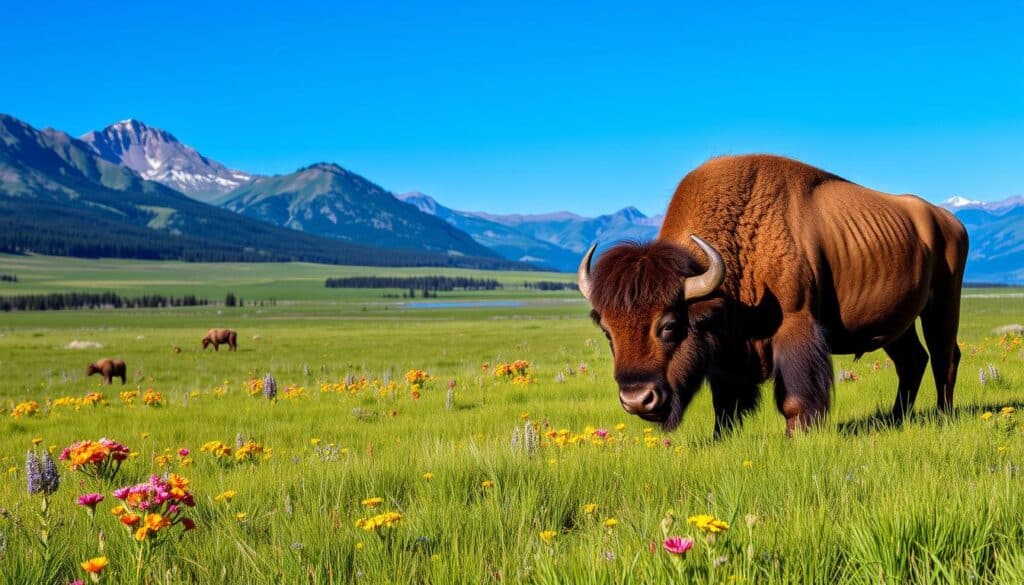Yellowstone National Park is home to a large population of bison, also known as American buffalo, with an estimated 5,500 individuals as of August 2016. These majestic creatures are a symbol of the park’s rich wildlife and natural beauty, and play a crucial role in maintaining the ecosystem. The bison in Yellowstone National Park are a significant part of the park’s history and culture, with a population that has been growing steadily over the years.
The yellowstone national park bison are an iconic species, with a weight range of up to 2,000 lbs for males and up to 1,100 lbs for females. The bison in yellowstone are known for their distinctive appearance and behavior, and are a popular attraction for visitors to the park. With their ability to reach speeds of up to 35 miles per hour and jump over objects up to 5 feet high, the bison in Yellowstone are a force to be reckoned with.
The conservation efforts for the bison in Yellowstone National Park are crucial to maintaining a healthy and sustainable population. The National Wildlife Federation’s Adopt-a-Wildlife-Acre program supports bison, wolves, and other wildlife outside of Yellowstone protected borders, and compensation to ranchers for grazing privileges aims to reduce wildlife conflicts. With the estimated population of bison in the Great Plains prior to exploration being around 20 million, and only a little over 1,000 remaining by the year 1900, the conservation efforts for the bison in Yellowstone are vital to the species’ survival.
Key Takeaways
- The estimated population of bison in Yellowstone National Park as of August 2016 is 5,500 individuals.
- The bison in Yellowstone are a keystone species, playing a crucial role in maintaining the ecosystem.
- The yellowstone national park bison are an iconic species, with a weight range of up to 2,000 lbs for males and up to 1,100 lbs for females.
- The conservation efforts for the bison in Yellowstone National Park are crucial to maintaining a healthy and sustainable population.
- The bison in yellowstone are a popular attraction for visitors to the park, with their distinctive appearance and behavior.
- The National Wildlife Federation’s Adopt-a-Wildlife-Acre program supports bison, wolves, and other wildlife outside of Yellowstone protected borders.
Overview of Bison in Yellowstone National Park
Yellowstone National Park is home to a large and healthy population of bison, with yellowstone bison facts indicating that the population has ranged from 3,000 to nearly 6,000 individuals in recent years. To see bison in yellowstone, visitors can head to the Lamar and Hayden Valleys, which are known for their abundant wildlife and scenic beauty.
Some interesting yellowstone bison facts include their impressive size, with males weighing up to 2,000 pounds, and their ability to run at speeds of up to 30 miles per hour. Bison are also skilled jumpers, able to clear objects up to 5 feet high. For those looking for where to see bison in yellowstone, the park’s central breeding area is a great place to start, with its rolling hills and grasslands providing a perfect habitat for these amazing animals.
- Bison can live for 12 to 15 years in the wild
- They are herbivores, feeding on grasses and sedges
- They are skilled migrators, traveling up to 70 miles between summer and winter ranges
By understanding these yellowstone bison facts and knowing where to see bison in yellowstone, visitors can appreciate the importance of conservation efforts and respect the park’s wildlife and habitats.
Characteristics of the Yellowstone Bison
The yellowstone bison population is known for its distinctive physical appearance, with a large, hooved body and a prominent hump on their back. They are social animals that live in large herds, led by a dominant male. The yellowstone bison habitat plays a crucial role in their survival, with the park’s vast grasslands and forests providing them with the necessary food and shelter.
Some key characteristics of the Yellowstone bison include:
- Large body size, with adult bulls weighing up to 2,000 pounds
- Prominent hump on their back, which is made of muscle and bone
- Shaggy coat, which helps to keep them warm in the cold winter months
- Social behavior, with bison living in large herds led by a dominant male
The yellowstone bison population has been steadily increasing over the years, with the current population estimated to be around 6,000 animals. The yellowstone bison habitat is an essential component of their survival, and conservation efforts are in place to protect and preserve their habitat.
| Year | Yellowstone Bison Population |
|---|---|
| 2020 | 4,800 |
| 2016 | 5,500 |
| 2000 | 2,400-5,500 |
Where to Spot Bison Within the Park
Yellowstone National Park is a vast and beautiful area, offering many opportunities to spot bison in their natural habitat. To increase your chances of seeing these amazing creatures, it’s essential to know where to look. When considering where to see bison in Yellowstone, the Lamar and Hayden Valleys are two of the best locations. These areas are known for their abundant wildlife, including bison, elk, and grizzly bears.
Visitors can drive through the park’s scenic routes, such as the Grand Loop Road, to spot bison in their natural habitat. The yellowstone bison migration patterns can be observed during the early morning or late evening when they are most active. Some popular spots for bison viewing include:
- Hayden Valley, situated six miles north of Fishing Bridge
- Lamar Valley, known to be the gathering spot for Yellowstone’s northern herd
It’s crucial to maintain a safe distance from bison, at least 25 yards, to avoid any potential danger. The vehicle pullouts in Hayden Valley are critical for safe wildlife observation and traffic flow management due to the road’s two-lane structure. By knowing where to see bison in Yellowstone and following safety guidelines, you can have a unique and enjoyable experience observing these incredible animals in their natural habitat.

Remember to respect the bison and their habitat, and never approach or feed them. By doing so, you can help preserve the yellowstone bison migration patterns and ensure the long-term conservation of these amazing creatures.
| Location | Best Time to Visit |
|---|---|
| Hayden Valley | Early morning or late evening |
| Lamar Valley | Early morning or late evening |
The Role of Bison in Native American Culture
Bison have played a significant role in Native American culture for centuries, featuring in legends and stories that highlight their importance. The yellowstone bison history is deeply intertwined with the cultural heritage of Native American tribes, who have long revered these animals as a symbol of strength and resilience.
In many Native American cultures, the bison is considered a sacred animal, and its presence is often associated with spiritual and cultural significance. The bison in yellowstone are particularly important, as they are seen as a connection to the land and the ancestors. The birth of a white bison calf, for example, is a rare and significant event that is considered sacred by many Native American tribes.
Today, many Native American tribes continue to work towards conserving and protecting bison in yellowstone populations, recognizing the importance of these animals to their cultural heritage. By preserving the yellowstone bison history and protecting the bison that roam the park, Native American tribes can help ensure the long-term survival of these incredible animals and the cultural significance they hold.
Seasonal Changes and Their Impact on Bison
Yellowstone bison behavior is influenced by the changing seasons, with winter bringing harsh conditions that require adaptive strategies to survive. The bison’s thick coats and layer of fat help keep them warm, and they often migrate to lower elevations in search of food and shelter.
In the spring, yellowstone bison habitat begins to change, with the snow melting and new vegetation emerging. This is also the time when bison begin to mate, with dominant males competing for females. The mating season behavior is an important part of the bison’s social structure and ensures the continuation of the species.
Some key factors that affect yellowstone bison behavior and habitat include:
- Food availability: Bison migrate to areas with abundant food sources, such as grasses and plants.
- Water sources: Access to clean water is essential for bison, and they often gather near rivers, lakes, and ponds.
- Shelter: Bison seek shelter from harsh weather conditions, such as extreme cold or heat, and predators.

Understanding yellowstone bison behavior and habitat is crucial for conservation efforts and management of the species. By studying their seasonal changes and adaptations, we can better appreciate the importance of preserving their natural habitat and ensuring the long-term survival of these incredible animals.
| Season | Yellowstone Bison Behavior | Yellowstone Bison Habitat |
|---|---|---|
| Winter | Migrate to lower elevations, thick coats and fat layers | Lower elevations, snow-covered areas |
| Spring | Mating season, migration to new vegetation | Areas with new vegetation, access to water sources |
Conservation Efforts for Bison
The conservation of bison in Yellowstone National Park is a crucial aspect of maintaining the park’s ecosystem. Yellowstone bison conservation efforts are in place to protect the bison population and prevent human-bison conflicts. The National Park Service works with conservation organizations to protect bison habitats and manage grazing practices.
Some key statistics related to bison conservation include:
- The Department of the Interior supports 19 bison herds located in 12 states.
- The total bison population managed by DOI is approximately 11,000 bison across 4.6 million acres.
- DOI bison resources comprise one-third of all bison managed for conservation in North America.
The bison in yellowstone are considered the last truly wild herd of American plains bison, with over 99.7 percent genetic purity. Conservation efforts, such as the Yellowstone Bison Conservation Transfer Program, aim to protect and manage the bison population. The program requires bison to undergo 1.5 to 3 years of testing before they are certified as brucellosis-free.
Partnerships with conservation organizations, such as the InterTribal Buffalo Council, have led to the transfer of bison to Tribes across the country. These efforts contribute to the overall goal of yellowstone bison conservation and the protection of bison in yellowstone.
| Year | Number of Bison Transferred |
|---|---|
| 2019 | 55 |
| 2020 | 40 |
| 2021 | 50 |
| 2023 | 112 |
| 2024 | 116 |
The Bison’s Diet and Habitat Needs
Bison in Yellowstone National Park are herbivores, and their diet consists mainly of grasses, clover, and shrubs. The yellowstone bison diet is diverse and includes various plants that grow in the park’s meadows and river valleys. In terms of habitat, bison prefer areas with abundant food and water, such as meadows and river valleys.
The yellowstone bison habitat is varied and includes grasslands, forests, and wetlands. Bison can be found in different parts of the park, and their habitat needs are met by the park’s diverse landscape. Here are some key facts about the bison’s diet and habitat needs:
- Bison are herbivores and feed on a variety of grasses and plants.
- Their diet includes clover, shrubs, and other vegetation that grows in the park’s meadows and river valleys.
- Bison prefer habitats with abundant food and water, such as meadows and river valleys.
- Their habitat needs are met by the park’s diverse landscape, which includes grasslands, forests, and wetlands.

In terms of specific habitat requirements, bison need access to large areas of grazing land, as well as water sources and mineral deposits. The park’s habitat provides all of these necessities, making it an ideal place for bison to thrive.
| Habitat Type | Description |
|---|---|
| Grasslands | Open areas with grasses and wildflowers, providing abundant food for bison. |
| Forests | Wooded areas with trees and shrubs, providing shelter and protection for bison. |
| Wetlands | Areas with water and aquatic plants, providing a source of water and minerals for bison. |
Safety Guidelines for Viewing Bison
When engaging in yellowstone bison viewing, it’s essential to prioritize safety. Bison in yellowstone can be unpredictable, and maintaining a safe distance is crucial. According to park regulations, visitors should stay at least 25 yards away from bison at all times.
To ensure a safe and enjoyable experience, follow these guidelines:
- Maintain a safe distance of at least 25 yards from bison
- Stay on designated trails and avoid approaching or feeding bison
- Be aware of your surroundings and keep an eye out for bison in the area
Remember, bison can run at speeds of up to 35 mph, making them a formidable force. By following these safety guidelines, you can enjoy yellowstone bison viewing while minimizing the risk of injury or conflict with bison in yellowstone.

The Life Cycle of a Yellowstone Bison
The life cycle of a yellowstone bison is a fascinating process that spans approximately 15-20 years in the wild. Understanding the yellowstone bison life cycle is crucial for conservation efforts and appreciating the role of bison in yellowstone National Park. The cycle begins with the calving season, which typically takes place in the spring.
During this time, female bison give birth to calves after a gestation period of around 9-10 months. The calving season is a critical period for bison in yellowstone, as they are vulnerable to predators such as grizzly bears and wolves. As the calves grow, they become an integral part of the herd, learning essential skills from their mothers and other experienced bison.
Mating and Calving Season
The mating season, also known as the rut, typically occurs from late summer until September. During this time, male bison engage in intense competition for dominance and mating rights. Female bison become reproductively mature at about 2-3 years of age, while males reach maturity at around 5 years of age.
Lifespan and Natural Predators
Bison in yellowstone generally live for 12-15 years in the wild, although some individuals have been known to live into their 20s. The yellowstone bison life cycle is influenced by various factors, including food availability, disease, and predation. Natural predators, such as wolves and grizzly bears, play a crucial role in regulating the bison population and maintaining the balance of the ecosystem.
Unique Facts About Yellowstone Bison
Yellowstone National Park is home to a thriving population of bison, with over 5,400 animals roaming the park. One of the most interesting yellowstone bison facts is that the park is the only place where bison have lived continuously since prehistoric times. The bison in yellowstone are direct descendants of the last herd of wild bison in the west.
Some notable yellowstone bison facts include their impressive size, with males weighing up to 2,000 pounds and females weighing around 1,100 pounds. Bison are also skilled runners, reaching speeds of up to 35 miles per hour. In addition to their impressive physical abilities, bison in yellowstone play a crucial role in the park’s ecosystem, with their grazing habits helping to maintain the health of the park’s grasslands.
Population Trends Over the Years
The population of bison in yellowstone has fluctuated over the years, with a significant decline in the late 1800s due to habitat reduction and hunting. However, conservation efforts have helped to restore the population, with the park now home to one of the largest free-roaming bison herds in the country.
Fun Trivia to Share
Some interesting trivia about yellowstone bison facts includes their unique horns, which can grow up to 2 feet long, and their distinctive hump, which is made of muscle and bone. Bison in yellowstone are also known for their complex social structures, with females often forming close bonds with each other and their calves.
Visitor Centers and Educational Resources
For those interested in learning more about yellowstone bison education, the park offers a variety of visitor centers and educational resources. The Canyon Visitor Education Center is a great place to start, with interactive exhibits and audio-visual productions that provide insight into the park’s unique geology and ecology.
Visitors can also explore the park’s many trails, which cover over 1,000 miles, and participate in educational programs such as the Junior Ranger and Young Scientist programs. These programs allow families to engage with information and activities relevant to Yellowstone from home, and provide a fun and interactive way to learn about bison in yellowstone.
Some of the key educational resources available in the park include:
- Orientation films and safety short films
- Interactive exhibits and audio-visual productions
- Junior Ranger and Young Scientist programs
- Trailhead displays and wayside exhibits
Additionally, the park’s visitor centers and wayside exhibits serve millions of visitors each year, providing important information and safety messages. With so many resources available, visitors can gain a deeper understanding of the park’s natural and cultural resources, including yellowstone bison education and bison in yellowstone.
| Resource | Description |
|---|---|
| Canyon Visitor Education Center | Interactive exhibits and audio-visual productions |
| Junior Ranger and Young Scientist programs | Fun and interactive way to learn about Yellowstone |
| Trailhead displays and wayside exhibits | Important information and safety messages |
Events and Activities Centered Around Bison
As you explore the wonders of Yellowstone National Park, the bison stand as a testament to the resilience and enduring spirit of this iconic landscape. From special tours and programs to captivating photography opportunities, the park offers a multitude of ways to immerse yourself in the bison’s remarkable story.
Discover the Bison’s Cultural Significance
Yellowstone’s bison have long held a deep cultural significance for the Indigenous Peoples of the region. The Yellowstone Tribal Heritage Center will operate from May to October 2024, showcasing the rich traditions and connections shared between these majestic creatures and the First Nations. Visitors can engage in educational presentations, learn from Indigenous artists and scholars, and gain a deeper appreciation for the bison’s role in shaping this land.
Capture the Beauty of Bison
The “Yellowstone Revealed” event, scheduled from June to September 2024, offers a unique opportunity for photography enthusiasts. Across five park entrances, visitors can immerse themselves in tipi installations, capturing the bison in their natural habitat. Additionally, the “Voices of Yellowstone: First Peoples Celebration” in Gardiner, Montana, from August 4 to 10, 2024, promises to be a captivating celebration of Indigenous culture, with opportunities to witness the bison’s significance through art, demonstrations, and community gatherings.
As you plan your Yellowstone adventure, embrace the bison in yellowstone and their enduring legacy. From educational experiences to breathtaking photographic moments, the park’s events and activities centered around these majestic creatures will deepen your connection to this remarkable ecosystem and its enduring history.
